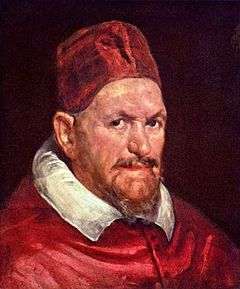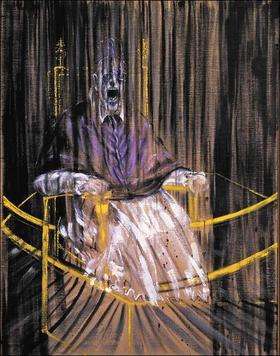Portrait of Innocent X

Portrait of Pope Innocent X is an oil on canvas portrait by the Spanish painter Diego Velázquez, executed during a trip to Italy around 1650. Many artists and art critics consider it the finest portrait ever created.[1] It is housed in the Galleria Doria Pamphilj in Rome. A smaller version is in the Metropolitan Museum of Art in New York, and a study is on display at Apsley House in London.[2] The painting is noted for its realism, in that it is an unflinching portrait of a highly intelligent, shrewd but aging man. He is dressed in linen vestments, and the quality of the work is evident in the rich reds of his upper clothing, head-dress, and the hanging curtains.
The pope, born Giovanni Battista Pamphilj, was initially wary of having his portrait taken by Velázquez, but relented after he was given reproductions of examples of Velázquez's portraiture. A contributing factor for this large advancement in the painter's career was that he had already depicted a number of members of Pamphilj's inner court. Yet the pope remained wary and cautious, and the painting was initially displayed to only his immediate family, and was largely lost from public view through the 17th and 18th centuries. The parchment held by the pope contains Velázquez's signature.
History
The portrait was painted during Velázquez's second voyage to Italy, between 1649 and 1651. The Pope's vestments being of light linen, it was probably painted during the summer, most likely in 1650. Velázquez included his signature on the paper the Pope is holding, but it is difficult to read the date. There are two versions of the story of how Velázquez came to paint the portrait. According to one of them, while visiting the Vatican City, Velázquez, already a renowned painter, was granted an audience with Pope Innocent X. He offered to paint a portrait of the Pope, but Innocent X doubted, mistrusting Velázquez's fame. Hence, he asked Veláquez to offer some proof of his painting skills. It would have been then that Velázquez painted the portrait of his servant Juan de Pareja (today at display in the Metropolitan Museum of New York). Once the Pope saw the portrait of Juan de Pareja, he allowed Velázquez to paint the portrait.[3]

Apparently, when the Pope saw the finished portrait, he exclaimed, somewhat disconcerted: "Troppo vero!" ("all too true!"), though he was not able to deny the intrinsic quality of the portrait as a masterpiece.[4] Experts doubt the veracity of this story, and argue that the Pope allowed Velázquez to paint him because he had already painted with great success other people from the inner papal court, including the Pope's own barber.
The portrait was kept at private display by Innocent's family, the Pamphilj, who would display it in the Doria-Pamphilj gallery where it remains to this day. It was a relatively secret masterpiece for much of the 17th and 18th centuries, only known to some connoisseurs who, nonetheless, would inevitably praise the work as one of the finest portraits ever produced. French historian Hippolyte Taine considered the portrait as "the masterpiece amongst all portraits" and said that "once it has been seen, it is impossible to forget".[5]
The art dealer René Gimpel noted in his diary in 1923 "Morgan would have offered a million dollars for it. Velázquez was faced with a ruddy Italian, and the artist, accustomed to the pale complexions of his country, unhesitatingly steeped his brush in red the color of wine and brought the bon vivant devastatingly to life.... That face is a whirlpool of flesh, and blood, and life; the eyes are searching."[6]
Influence
The Irish-born painter Francis Bacon painted a series of distorted variants often known as the "Screaming Popes", which consist of more 45 known variants executed throughout the 1950s and early 1960s.[7] The picture was described by Gilles Deleuze as an example of creative re-interpretation of the classical.. Bacon avoided seeing the original, but the painting remained the single greatest influence on him; its presence can be seen in many of his best works from the late 1940s to the early 1960s. In 1953 Bacon's version, the Pope is shown screaming yet his voice is "silenced" by the enclosing drapes and dark rich colors. The dark colors of the background lend a grotesque and nightmarish tone to the painting.[8] The pleated curtains of the backdrop are rendered transparent and appear to fall through the representation of the Pope's face.[9]
References
- ↑ Vid. Ernest Gombrich, The History of Art, Phaidon Press Limited, 1995, Chapter 19
- ↑ http://www.bbc.co.uk/arts/yourpaintings/paintings/pope-innocent-x-1650
- ↑ Gombrich, E. "The Story of Art." London: Phaidon, 1950
- ↑ http://www.wga.hu/tours/spain/velazqu1.html
- ↑ Bosky, Bernadette Lynn, "Hippolyte-Adolphe Taine", Cyclopedia of World Authors
- ↑ Gimpel, (John Roseberg, tr.)Diary of an Art Dealer 1966:190.
- ↑ Schmied, 17
- ↑ Schmied, 20
- ↑ Peppiatt, 148
Sources
- Peppiatt, Michael. Anatomy of an Enigma. Westview Press, 1996. ISBN 0-8133-3520-5
- Schmied, Wieland. Francis Bacon: Commitment and Conflict. Munich: Prestel, 1996. ISBN 3-7913-1664-8

